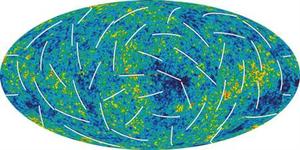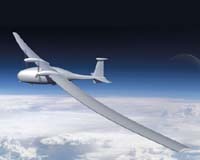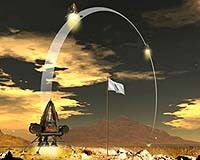Questions about human migration from Asia to the Americas have perplexed anthropologists for decades, but as scenarios about the peopling of the New World come and go, the big questions have remained. Do the ancestors of Native Americans derive from only a small number of "founders" who trekked to the Americas via the Bering land bridge? How did their migration to the New World proceed? What, if anything, did the climate have to do with their migration? And what took them so long?
A team of 21 researchers, led by Ripan Malhi, a geneticist in the department of anthropology at the University of Illinois, has a new set of ideas. One is a striking hypothesis that seems to map the peopling process during the pioneering phase and well beyond, and at the same time show that there was much more genetic diversity in the founder population than was previously thought.
Julie Steenhuysen
ReutersFri, 26 Oct 2007 01:54 UTC
A cold spot in the oldest radiation in the universe could be the first sign of a cosmic glitch that might have originated shortly after the Big Bang, British and Spanish scientists said on Thursday.

|
| ©REUTERS/NASA/WMAP Science Team/Handout
|
| An undated image of the infant universe with "warmer" spots represented by red and "cooler" spots represented by blue, produced by NASA's Wilkinson Microwave Anisotropy Probe satellite.
|
New features of botnets created by the infamous Storm Worm allow denial of service attacks to be launched against security defenders that attempt to interrupt its operation.
Attempts to probe command-and-control servers can result in a withering counter-attack of malicious traffic that can swamp the internet connections of security activists for days, according to Josh Korman, host-protection architect the ISS security division of IBM.
Ancient DNA retrieved from the bones of two Neanderthals suggests that at least some of them had red hair and pale skin, scientists report this week in the journal Science. The international team says that Neanderthals' pigmentation may even have been as varied as that of modern humans, and that at least 1 percent of Neanderthals were likely redheads.
The scientists -- led by Holger Römpler of Harvard University and the University of Leipzig, Carles Lalueza-Fox of the University of Barcelona, and Michael Hofreiter of the Max Planck Institute for Evolutionary Anthropology in Leipzig -- extracted, amplified, and sequenced a pigmentation gene called MC1R from the bones of a 43,000-year-old Neanderthal from El Sidrón, Spain, and a 50,000-year-old individual from Monti Lessini, Italy.
A distant comet that was as faint as magnitude 18 on October 20th has suddenly brightened by a millionfold, altering the naked-eye appearance of the constellation Perseus.
This startling outburst of Comet Holmes (17P) may be even stronger than the one that occurred 115 years ago, in November 1892, when the comet was first spotted by English amateur Edwin Holmes.
In January 1955, Homer Jacobson, a chemistry professor at Brooklyn College, published a paper called "Information, Reproduction and the Origin of Life" in American Scientist, the journal of Sigma Xi, the scientific honor society.
In it, Dr. Jacobson speculated on the chemical qualities of earth in Hadean time, billions of years ago when the planet was beginning to cool down to the point where, as Dr. Jacobson put it, "one could imagine a few hardy compounds could survive."
Nobody paid much attention to the paper at the time, he said in a telephone interview from his home in Tarrytown, N.Y. But today it is winning Dr. Jacobson acclaim that he does not want - from creationists who cite it as proof that life could not have emerged on earth without divine intervention.
Boeing, using a Ford Motor Company-developed hydrogen engine, has successfully tested the hydrogen propulsion system of its High Altitude Long Endurance (HALE) unmanned aircraft. "This test demonstrates the technical readiness of the hydrogen engine system and confirms the capability breakthrough in flight endurance and altitude that could be realized by a variety of military and commercial customers," said Darryl Davis, vice president and general manager, Boeing Advanced Precision Engagement and Mobility Systems.

|
| ©Boeing Illustration - Chuck Schroeder
|
During the X PRIZE Cup Oct. 27-28, NASA's Centennial Challenges Program will offer prizes totaling $2 million if competing teams successfully meet the requirements of the Northrop Grumman Lunar Lander Challenge. The challenge will take place at Holloman Air Force Base, in Alamogordo, N.M.

|
| ©Unknown
|
Annalee Newitz
AlterNetWed, 24 Oct 2007 17:57 UTC
Two scandals rocked the sci-tech world last week. Not to put too fine a point on it, they reminded us that bad research and implementation can kill.
In South Africa, a widely used antiaircraft cannon called the Oerlikon GDF-005 suffered from what many observers believe was a computer malfunction, which killed nine soldiers and maimed 15 in a training exercise. Its computer-controlled sighting mechanism went haywire, and the gun automatically turned its barrel to face the trainees next to it, spraying bullets from magazines that it automatically reloaded until it was out of ammunition. Many compared the incident to science fiction fare like Robocop or Terminator, in which military bots turn on their masters.
In an attempt to recover the lost works of Aristotle, Sophocles and Catullus, archaeologists are to restart excavations at the ancient city of Herculaneum in Italy, where a Roman library lies buried beneath 90 ft of lava from the eruption of Mount Vesuvius in AD 79.
"It is impossible, absolutely impossible, to excavate Villa dei Papyri without finding fantastic things. We may find the lost scrolls of Aristotle, or we may find something even more exciting that we had not even thought of yet," Andrew Wallace-Hadrill, the Director of the Herculaneum Conservation Project, told The Daily Telegraph.
